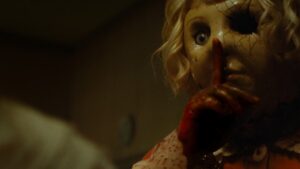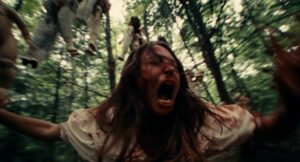A romantic hike quickly unravels into a nightmare of captivity, role-playing, and blood-soaked survival.
Dolly plunges into the horrors of obsession, control, and survival. The film delivers a relentless descent into madness, leaving audiences unsettled long after the final frame. Directed by Rod Blackhurst, co-written with Brandon Weavil, the film wastes no time throwing its characters and viewers into unease. The early moments follow Chase (Seann William Scott) and his girlfriend Macy (Fabienne Therese) on what should be an innocent outing. Chase plans to propose, Macy quietly questions her readiness for family life, and the woods around them appear inviting. But when the couple stumbles upon what seems to be a bizarre display of dolls, everything shifts. Violence erupts, Chase is brutally attacked, and Macy is dragged into a surreal nightmare.
Fabienne Therese delivers a standout performance as Macy, anchoring the film with raw intensity. She portrays a woman thrust into survival mode, cycling through shock, terror, and determination. Her Macy is not a passive victim but a fighter, clawing for escape even as she is dressed in frills and infantilized by her captor. The performance balances resilience with vulnerability, keeping the audience tethered to her plight. Opposite her, Seann William Scott surprises in one of his most brutal roles to date. As Chase, he embodies both warmth and desperation, a man caught in the wrong place at the worst possible time. His physicality in the film’s opening attack sets the tone for the brutality to come, while his emotional connection to Macy provides fleeting glimpses of humanity amidst the carnage.
Of course, the film’s most unforgettable presence is Dolly itself. Cloaked in a pink dress and porcelain mask, wielding a shovel as a signature weapon, Dolly is an image of distorted innocence. The performance is chilling not only because of its violence but because of its warped desire to nurture. Visually, Dolly embraces its inspirations. The 70s-style cinematography, warm color grading, and grainy textures give the film the tactile quality of a lost exploitation classic. The camera lingers on disturbing imagery, a cracked porcelain mask, a pristine nursery deep in the woods, and blood-soaked dolls, turning them into icons of terror. The use of silence and sudden bursts of sound heighten unease, while the score pulses with dread, amplifying the grotesque contrast between childlike play and adult violence. The film leans into its extremity, embracing gore, violence, and unnerving imagery without apology. Macy’s transformation into a “human doll” is both cringeworthy and terrifying. Characters spit up blood, wander too far into the woods, and yet survive in ways that challenge audience expectations. The combination of visceral violence and psychological torment ensures that Dolly is not just a cat-and-mouse game, but an exploration of power, survival, and the loss of autonomy.
While Dolly may not appeal to viewers who prefer restrained horror, it thrives as a brutal, uncompromising survival story giving similarities of movies such as Barbarian, House of Wax, and The Hills Have Eyes. With strong performances, relentless pacing, and an aesthetic that blends the surreal with the grotesque, it positions itself as one of the year’s most disturbing genre entries. It does not provide comfort, but it does provide one wild ride and fight for survival.


